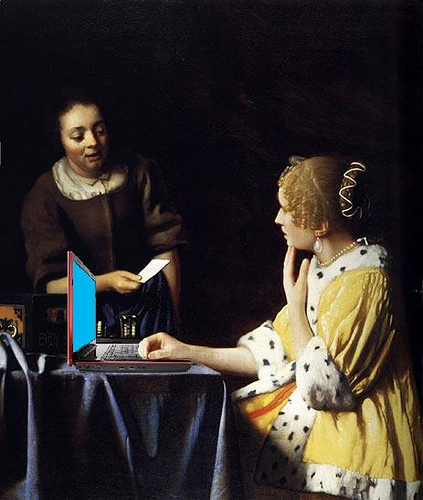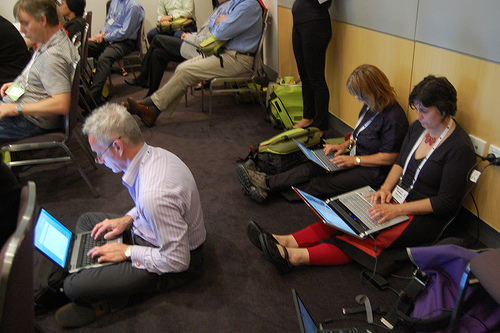Although I didn’t participate in today’s #assnchat about ASAE’s Great Ideas Conference, it still inspired a blog post. Thank you, KiKi! Here’s why.
I must confess I never went into the creativity rooms at Great Ideas. I peeked into one, but it looked like a dolled-up regular meeting room to me. Maybe I missed something. Maybe I missed it completely. I thought I saw toys on the tables. Or did my eyes deceive me? It’s a shame I didn’t go in and explore, but the timing was never right.
And table toys don’t do much for me. I swear I’m not that serious a person. I’ve attended sessions with group activities centered around toys or other building-block-type things. It’s forced fun for a while. People relax a bit and some get really competitive: “Ours will be bigger!” Perhaps playing with toys shifts our mindset from serious office mode to relaxed engaged conference mode. And, yes, we’re using our creativity, but it seems so forced. And passé, isn’t it? Ok, call me a kill-joy. Then, after a rousing round of construction, the hubbub dies down and we sit passively for the next 30 to 40 minutes listening to the speaker and sneaking glances at the silly-looking fort on our table.
The association professionals in today’s Twitter chat had plenty of great ideas (heh heh) for conference creativity rooms and I even have a few of my own.
Exercise: @AssnMetrics would include “some piece of exercise equipment to put my body in a different state from just sitting.” That reminded me of the Snap Learning Spot sponsored by the Canadian Tourism Commission at Great Ideas where my friend Rob Barnes rode an exercise bike for 35 miles while listening to a micro-learning session. His miles on the bike also raised money for charity. I can imagine a creativity room with a bunch of exercise bikes (or treadmills or ellipticals) for people who want to chat while firing up their mind and body. Maybe some air hockey too. If you rather get outside, the room could be a meeting place for people who want to take scheduled or random walks or hikes.
F&B: The Canadians also served poutine at one point during the conference. I’m sorry I missed it! But, that leads me to my second creativity room feature – food and beverages. @SarahJanetHill and @strattonpub had the same idea. Definitely provide coffee, tea, water and other healthy beverages. Our brains need fuel. Have sign-ups for sommelier- or Cicerone-led wine and beer tastings at the end of the day. The food for the room could be made by people attending mini-cooking classes.
Mini-classes: Why stop at cooking classes? People can sign up in advance to teach people how to knit, play Texas Hold ‘Em or the acoustic guitar, or whatever.
Arts and crafts: @SarahJanetHill said she likes “playdoh or pipecleaners or something to keep my hands busy. Helps keep my brain engaged.” @ASegar added, “craft paper, scissors, glue.” Who doesn’t like arts and crafts? Let’s make lunch centerpieces, art projects, lanyards or badge decorations – it’s like camp!
Puppy room: @k8doyle suggested this brilliant idea. But where do the puppies (or kitties) come from? Why the Humane Society or SPCA, of course! They can talk to folks about fostering pets, pet care, and other topics.
Music: @ToeKneeRay wants music and I agree. Even at a low (and adjustable) volume, it will energize people. Live music throughout the venue would be even better, if you can afford it.
Furniture: @strattonpub requests “comfortable seating for solo and group work, lots of natural lighting, warm colors/décor.” I’d add all kinds of plants too – ferns, cacti, succulents, leafy plants, etc. @craigsorrell would like “a room of rocking chairs so you can sit and chat with attendees.” I envision a big room with some private spaces for those who need a bit of solitude. A room with a view would be ideal. Or a few rooms scattered throughout the venue, each with their own character.
Shazam: Wouldn’t it be cool to go somewhere and let your creativity and intellect go crazy in conversation with other attendees? Maybe speakers would pop by and ask questions that encourage wild thinking and wondering. Or whoever is staffing the room would come armed with provocative questions and topics, and not just professional ones.
Tools: @ASegar would stock “flipcharts, postable walls, sticky notes, pens” and @strattonpub would include a “whiteboard or chalkboard.” Make it a good place to let the mind wander and work out issues. Provide magazines and iPads too – tether them if you wish. Who knows, maybe you can get a group visionboard activity going.
Introvert-friendly: @bussolati said “My ideal creativity room would be just me… Introverts unite!” She wasn’t alone in that sentiment. We can create creativity rooms that include quiet space where we can recharge alone.
@ThadLurie shared an article by Susan Cain, The Rise of the New Groupthink. “We need to move beyond the New Groupthink and embrace a more nuanced approach to creativity and learning,” said Cain. “Our offices should encourage casual, cafe-style interactions, but allow people to disappear into personalized, private spaces when they want to be alone.” Replace offices with conferences.
I know we’re at conferences primarily to meet and deepen relationships, oh, yeah, and to get an education too, but I wouldn’t mind a bit more downtime or white space, even if it means extending the conference. I hate having to skip a session just so I can go for a walk while it’s light out.
What do you think? What’s in your ideal creativity room? And how do you recharge when you’re in the midst of a conference?











